Structuring and Recommendations for Research on the Construction of Intelligent Multi-Industry and Multihazard Emergency Planning Systems
Abstract
1. Introduction
2. System Design
2.1. Overall Structure
2.2. Emergency Preparedness Management System Module
2.3. Principles of Reasoning Based on Support Vector Machine Cases
- (1)
- Input the training dataset:
- (2)
- Output the separating hyperplane and classification decision functions:
- (3)
- Find the hyperplane:
2.4. Application of Case-Based Reasoning Using Support Vector Machine Algorithm
2.5. Case Reasoning Assessment
3. Practical Example
4. Conclusions
- (1)
- The emergency plan management in this study has nine functions for realizing the information and organizational management of emergency plans.The system automatically recommends similar emergency plans by performing similarity calculations from the case base, thereby enhancing the efficiency of the emergency plan preparation process.
- (2)
- By utilizing the fuzzy analytic hierarchy process, more reasonable and scientific feature weights can be obtained, enabling the scientific evaluation of emergency plans and enhancing their practicability.
- (3)
- Considering the current landscape of accidents and disasters involving multiple types of operations and hazards, the structured emergency plan and intelligent recommendation system developed in this research can be applied for a range of urban public safety rescue efforts. This provides a novel reference method for enhancing modern urban emergency response capabilities.
Author Contributions
Funding
Institutional Review Board Statement
Informed Consent Statement
Data Availability Statement
Conflicts of Interest
References
- Wang, J.; Zhu, W.; Gao, Y. Study on technical schemes for structured and processed emergency plan from digital perspective. J. Saf. Sci. Technol. 2018, 14, 164–168. [Google Scholar]
- Zhang, Y.; Wang, Y.-H.; Zhao, X.; Tong, R.-P. Dynamic probabilistic risk assessment of emergency response for intelligent coal mining face system, case study: Gas overrun scenario. Resour. Policy 2023, 85, 103995. [Google Scholar] [CrossRef]
- Kimutis, N.; Wall, T.; Darrow, L. Emergency management short term response to extreme heat in the 25 most populated U.S. cities. Int. J. Disaster Risk Reduct. 2024, 100, 104097. [Google Scholar] [CrossRef]
- Will, L. Requirements for Operations to Take Advantage of the Flexibility of Soa. Comput. Sci. Eng. 2012, 2, 68–76. [Google Scholar] [CrossRef]
- Grimaila, M.R.; Badiru, A. A hybrid dynamic decision making methodology for defensive information technology contingency measure selection in the presence of cyber threats. Oper. Res. 2013, 13, 67–88. [Google Scholar] [CrossRef]
- Sunley, R.; Cannon, R.A.; Eyre, D.; Baker, R.H.A.; Battisti, A.; Giltrap, N.; Griessinger, D. A decision-support scheme that generates contingency plans and prioritizes action during pest outbreaks*. Eppo Bull. 2012, 42, 89–92. [Google Scholar] [CrossRef]
- Yin, X. Research on Dynamic Generation of Unconventional Emergency Plan Based on Ontology; Nanjing University of Posts and Telecommunications: Nanjing, China, 2016. [Google Scholar]
- Zhang, P.; Li, X.J.; He, Q.M. Extraction of Building Information Based on Multi-Source Spatiotemporal Data for Earthquake Insurance in Urban Areas. Appl. Sci. -Basel 2023, 13, 6501. [Google Scholar] [CrossRef]
- Lu, R. Research on the Evaluation Method of Emergency Plans Based on Process; Dalian University of Technology: Dalian, China, 2013. [Google Scholar]
- Zhong, L. Research on Emergency Decision-Making Method Based on Scenarios and Digital Plans in Urban Rail Transit; Beijing Jiaotong University: Beijing, China, 2014. [Google Scholar]
- Ricci, F.; Yang, M.; Reniers, G.; Cozzani, C. Emergency response in cascading scenarios triggered by natural events. Relia-Bility Eng. Syst. Saf. 2024, 243, 109820. [Google Scholar] [CrossRef]
- Bruccoli, A.M. Implementation of a Behavioral Emergency Response Team in the Emergency Department. J. Emerg. Nurs. 2023, 49, 395–402. [Google Scholar] [CrossRef]
- Taghizadeh, M.; Mahsuli, M.; Poorzahedy, H. Probabilistic framework for evaluating the seismic resilience of transportation systems during emergency medical response. Reliab. Eng. Syst. Saf. 2023, 236, 109255. [Google Scholar] [CrossRef]
- Cai, J.; Wu, J.; Yuan, S.; Reniers, G.; Bai, Y. Risk-based optimization of emergency response systems for accidental gas leakage in utility tunnels. Reliab. Eng. Syst. Saf. 2024, 244, 109947. [Google Scholar] [CrossRef]
- Kang, J.; Wang, Z.; Wang, Q.; Dai, H.; Zhang, J.; Wang, L. Temporal assessment of emergency response and rescue capability for hybrid hydrogen-gasoline fueling stations based on dynamic scenario construction. Int. J. Hydrog. Energy 2024, 56, 358–368. [Google Scholar] [CrossRef]
- Wu, Y.; Chen, S. Traffic resilience modeling for post-earthquake emergency medical response and planning considering disrupted infrastructure and dislocated residents. Int. J. Disaster Risk Reduct. 2023, 93, 103754. [Google Scholar] [CrossRef]
- Kara, M. A Comprehensive Framework for Emergency in Robotic Environments. IEEE Access 2023, 11, 82539–82547. [Google Scholar] [CrossRef]
- Luo, Y.; Gu, Y. The study of digital emergency preplan’s stored model and producing method. J. Guangzhou Univ. 2013, 12, 71–77. [Google Scholar]
- Arvidsson, R.; Soderman, M.L.; Sanden, B.A.; Nordelöf, A.; André, H.; Tillman, A.-M. A crustal scarcity indicator for long-term global elemental resource assessment in LCA. Int. J. Life Cycle Assess. 2020, 25, 1805–1817. [Google Scholar] [CrossRef]
- Li, S.; Guo, Y.; Chen, S. Construction method of iconic emergency plan for petrochemical industry. Comput. Appl. Chem. 2016, 33, 260–264. [Google Scholar]
- Zhang, X.J.; Wang, C.; Wang, W.Q.; Zhang, H.B. Inter-organizational collaboration after institutional reform in China: A perspective based on the revision of the emergency plan. Int. J. Disaster Risk Reduct. 2023, 98, 104084. [Google Scholar] [CrossRef]
- Tong, Q.; Zhang, J.; Chen, C. Study of Structural and Visual Plan of Emergency Command System. Comput. Eng. 2011, 37, 275–278. [Google Scholar]
- Zhang, X.Y.; Chen, G.; Shi, J. Simulation of guided crowd evacuation scheme of high-speed train carriage. Int. J. Simul. Model. 2023, 22, 110–120. [Google Scholar] [CrossRef]
- Wang, G.; Xu, Y.; Ren, H. Intelligent and ecological coal mining as well as clean utilization technology in China: Review and prospects. Int. J. Min. Sci. Technol. 2019, 29, 161–169. [Google Scholar] [CrossRef]
- Cai, J.M.; Sun, F.; Hu, S.Y.; Li, H.B.; Xing, H.G. Research on cross-organizational emergency collaboration networks based on functional modules: An example of landslide disaster incident in Shuicheng, Guizhou, China. Int. J. Disaster Risk Reduct. 2023, 97, 104043. [Google Scholar] [CrossRef]
- Bu, Z.H.; Liu, J.C.; Zhang, X.X. Factors affecting the resilience of subway operations under emergencies—Using improved DEMATEL model. Kybernetes 2023. [Google Scholar] [CrossRef]
- Yang, S.; Zhu, X.; Tan, B. Evaluation standard of mine emergency rescue force capability based on cloud model. Saf. Coal Mines 2021, 52, 250–255. [Google Scholar]
- Horton, D.; Spigelmyer, P.; Zoucha, R.; Rebmann, T. Disaster Preparedness in K-12 Schools: An Integrative Review. J. Sch. Health 2023, 93, 726–732. [Google Scholar] [CrossRef] [PubMed]
- Yang, M.; Chen, N.; Fan, Y. Study on storage and retrieval of coal mine accident cases. Coal Sci. Technol. 2021, 49, 103–109. [Google Scholar]
- Zeng, L.; Wang, J.; Zhang, J.; Sun, Z.; Santibanez Gonzalez, E.D.R. A path matching model on new urbanization in mineral resource abundant regions. Resour. Policy 2021, 73, 102214. [Google Scholar] [CrossRef]
- Li, W.; Yi, P.; Zhang, D.; Zhou, Y. Assessment of coordinated development between social economy and ecological environment: Case study of resource-based cities in Northeastern China. Sustain. Cities Soc. 2020, 59, 102208. [Google Scholar] [CrossRef]
- Xiao, W.; Chen, W.; Deng, X. Coupling and coordination of coal mining intensity and social-ecological resilience in China. Ecol. Indic. 2021, 131, 108167. [Google Scholar] [CrossRef]
- Xing, L.; Xue, M.; Hu, M. Dynamic simulation and assessment of the coupling coordination degree of the economy–resource–environment system: Case of Wuhan City in China. J. Environ. Manag. 2019, 230, 474–487. [Google Scholar] [CrossRef]
- Liu, N.; Liu, C.; Xia, Y.; Da, B. Examining the coordination between urbanization and eco-environment using coupling and spatial analyses: A case study in China. Ecol. Indic. 2018, 93, 1163–1175. [Google Scholar] [CrossRef]
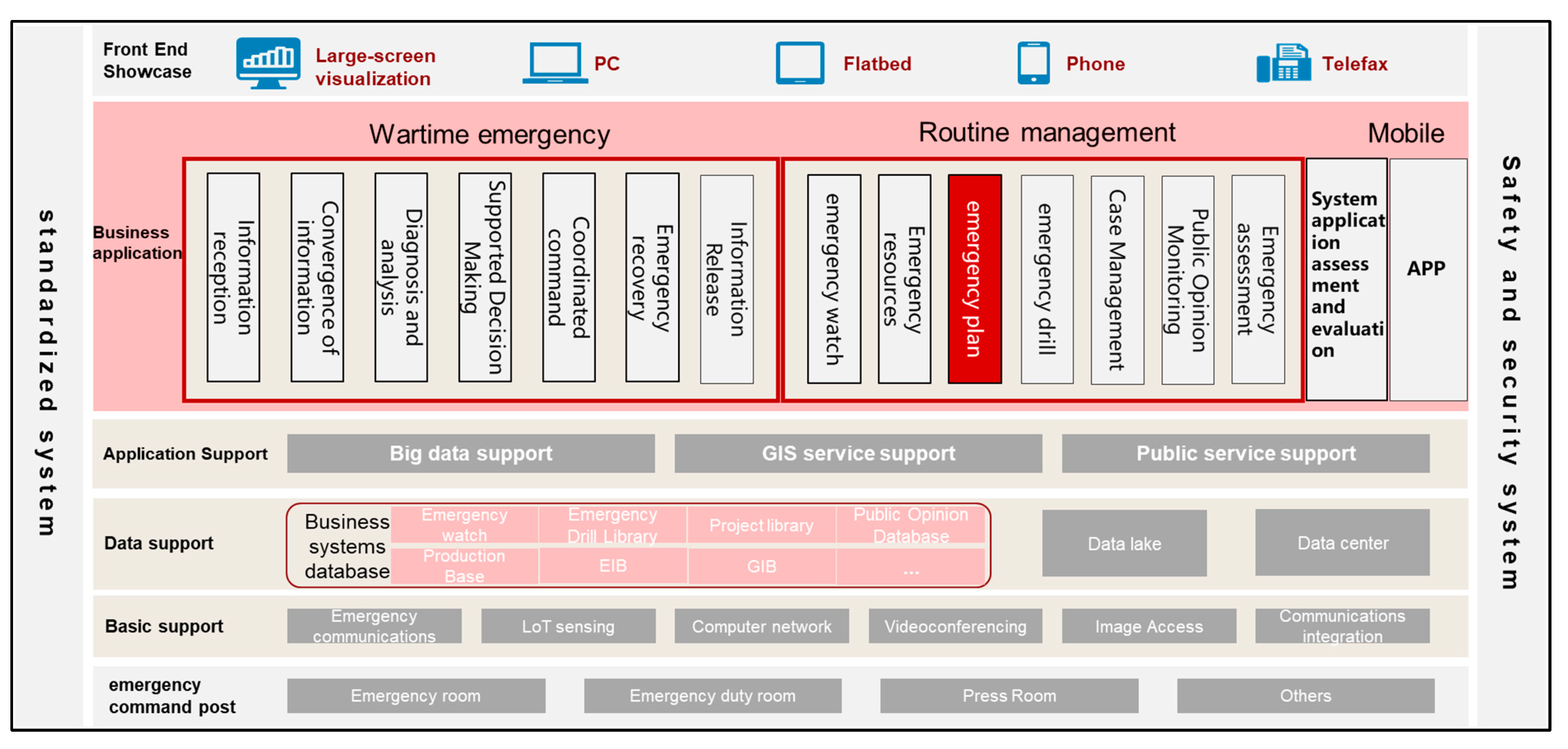



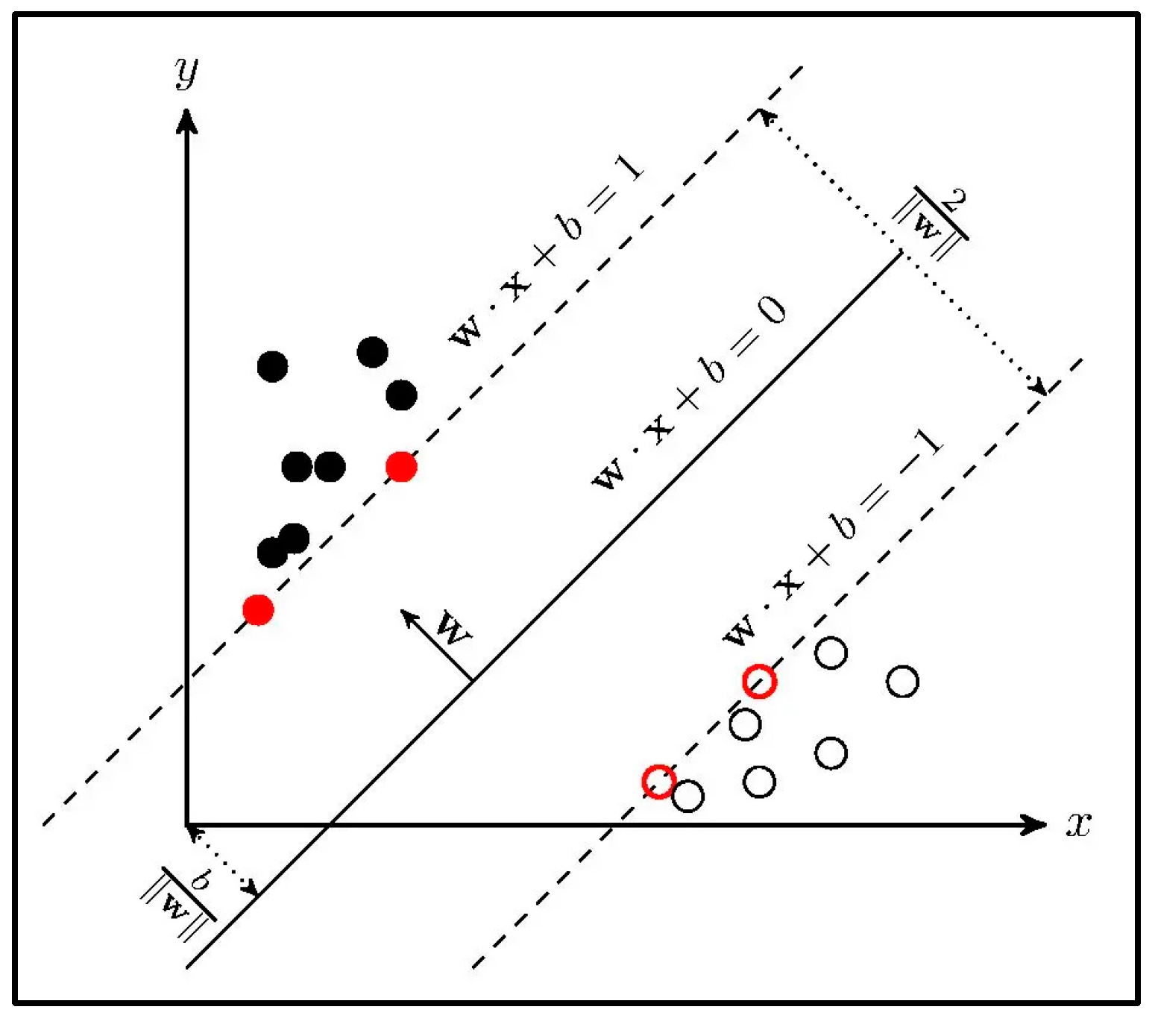
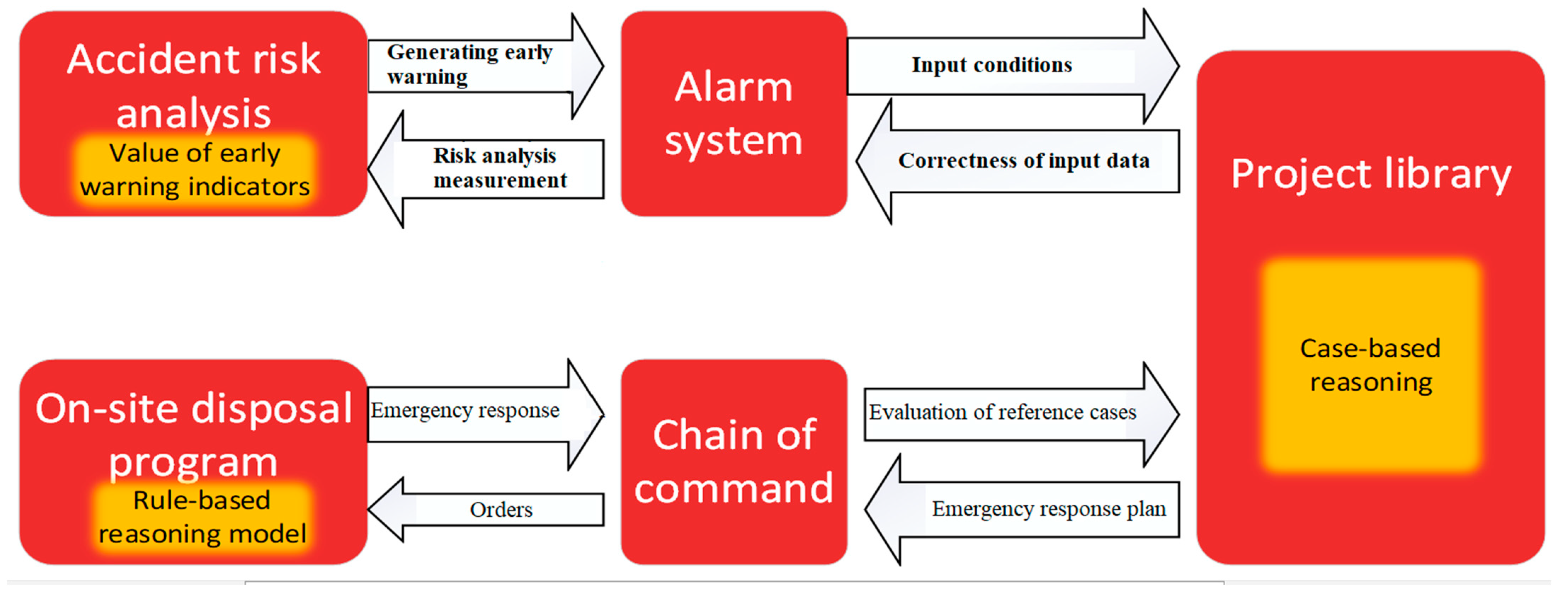

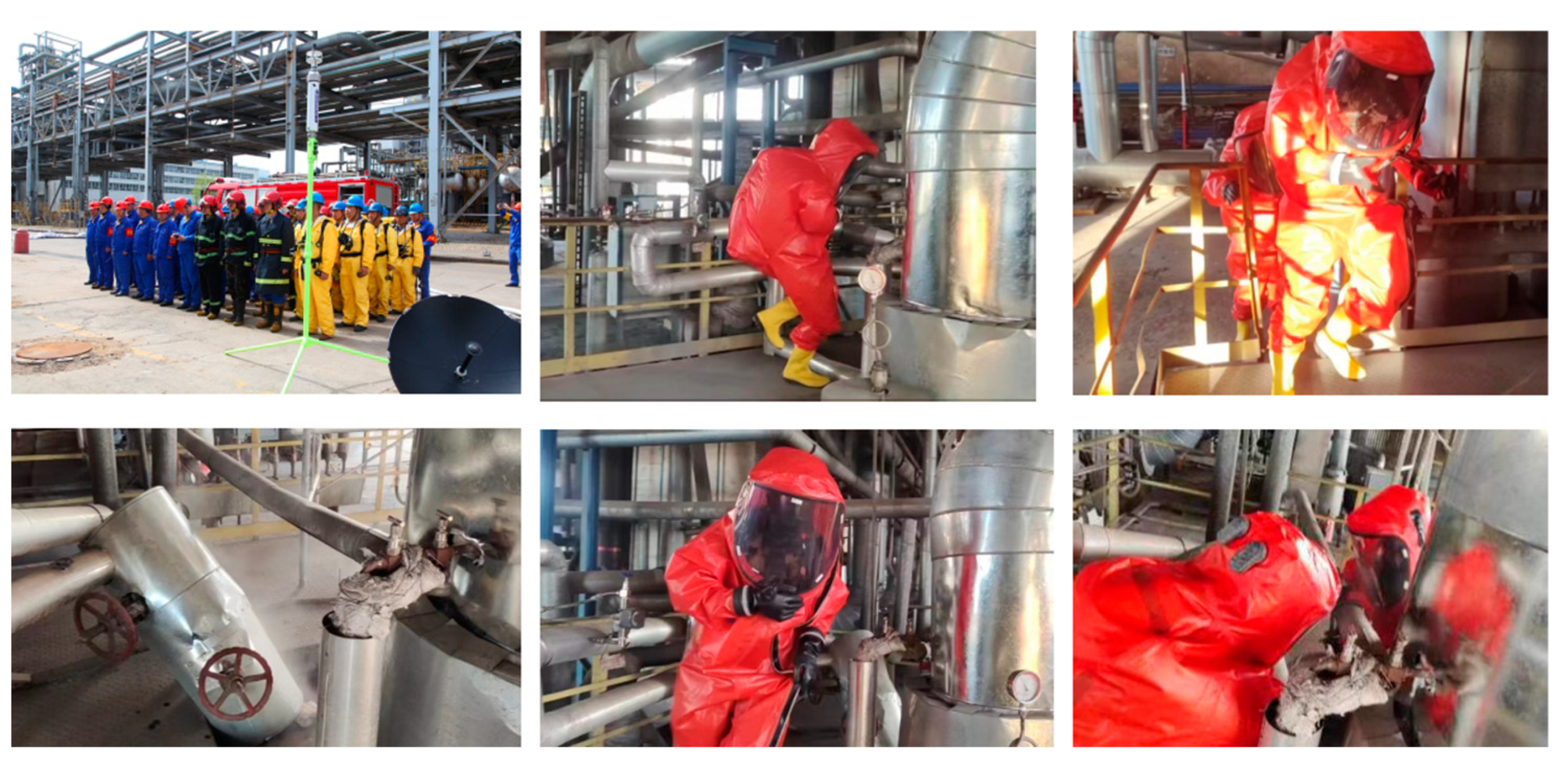
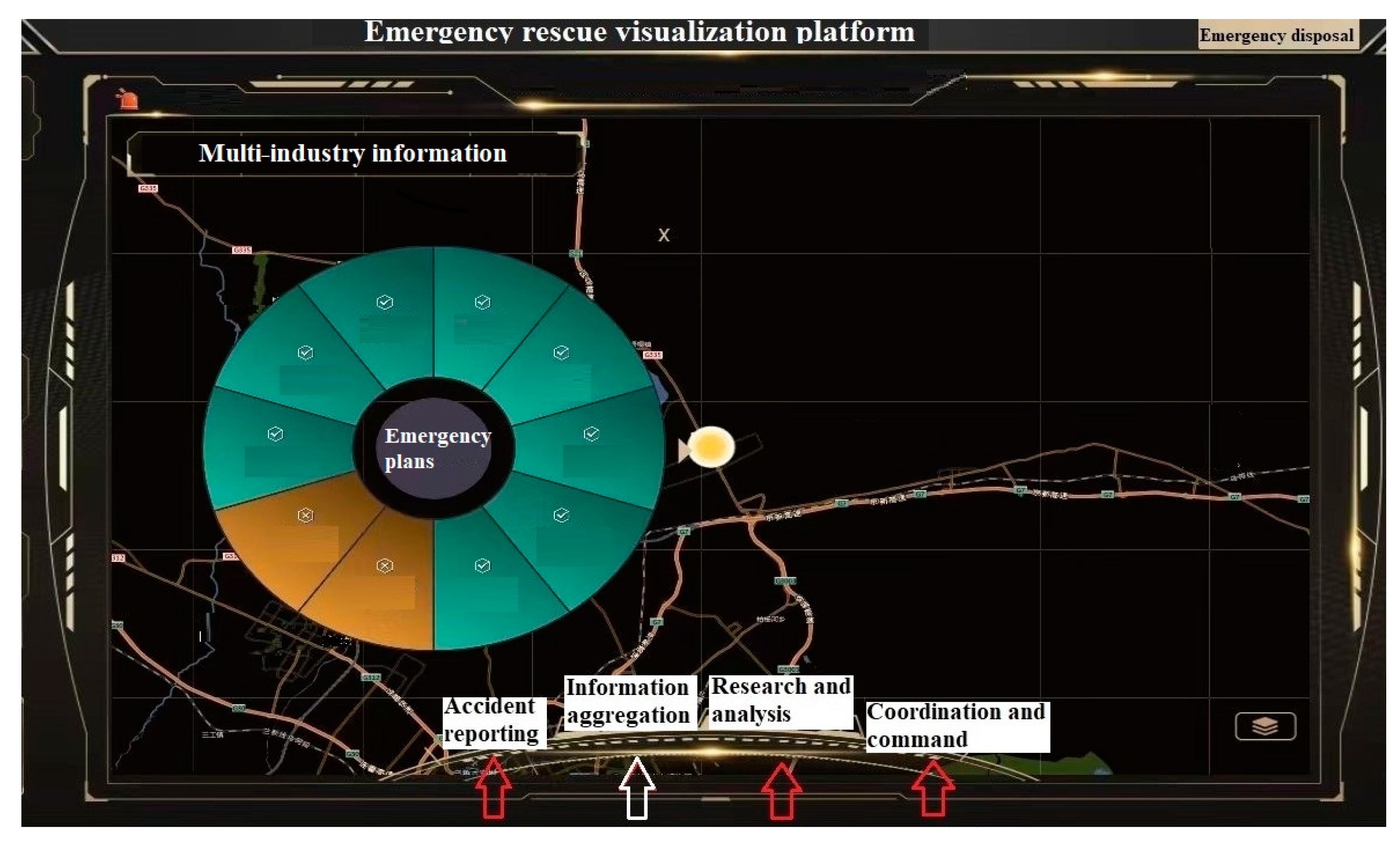
| Serial Number | Feature | Feature Attribute | Data Source | Assignment | Weighting |
|---|---|---|---|---|---|
| 1 | Type of accident | Natural disasters, accidents, and calamities | Source data | 8 | 0.2857 |
| 2 | Time specificity | Specific time and duration of the accident | Derived data | 3 | 0.1071 |
| 3 | Spatial features | The specific location of the accident, topography | Derived data | 4 | 0.1429 |
| 4 | Scale of the accident | The extent of impact, the extent of damage, number of people involved in the disaster | Source/derived data | 5 | 0.1786 |
| 5 | Impact of accidents | Impact on life, property, environment | Source/derived data | 3 | 0.1071 |
| 6 | Environmental conditions | Climate, temperature, humidity environmental factors | Source/derived data | 3 | 0.1071 |
| 7 | Resource requirements | Materials, technology, and other resources needed for incident response and rescue | Source data | 2 | 0.0714 |
| Serial Number | Emergency Response Link | Emergency Handling Node | Traditional Method/min | Time in the System Platform/min |
|---|---|---|---|---|
| 1 | Emergency watch | Sub-subsidiary warning | 0 | 0 |
| 2 | Sub-subsidiary responding | 2 | 0 | |
| 3 | Sub-subsidiary reporting | 10 | 0 | |
| 4 | Subsidiary warning | 5 | 0 | |
| 5 | Subsidiary responding | 10 | 0 | |
| 6 | Subsidiary reporting | 15 | 0 | |
| 7 | Parent company warning | 18 | 0 | |
| 8 | Parent company responding | 20 | 0 | |
| 9 | Parent company reporting | 60 | 0 | |
| 10 | Emergency team | Emergency team operation | 2 | 2 |
| 11 | Regional team collaboration | 30 | 10 | |
| 12 | Emergency supplies | Allocation of emergency supplies | 50 | 20 |
| 13 | Regional supplies sharing | 120 | 20 | |
| 14 | Emergency technique | Emergency data sharing | 60 | 10 |
| 15 | Emergency expert support | 120 | 30 | |
| 16 | Emergency case | Accident case search | 60 | 10 |
| 17 | Rescue plan | Accident analysis | 90 | 30 |
Disclaimer/Publisher’s Note: The statements, opinions and data contained in all publications are solely those of the individual author(s) and contributor(s) and not of MDPI and/or the editor(s). MDPI and/or the editor(s) disclaim responsibility for any injury to people or property resulting from any ideas, methods, instructions or products referred to in the content. |
© 2024 by the authors. Licensee MDPI, Basel, Switzerland. This article is an open access article distributed under the terms and conditions of the Creative Commons Attribution (CC BY) license (https://creativecommons.org/licenses/by/4.0/).
Share and Cite
Zhang, X.; Zhao, K.; Li, C.; Li, Y. Structuring and Recommendations for Research on the Construction of Intelligent Multi-Industry and Multihazard Emergency Planning Systems. Sustainability 2024, 16, 5882. https://doi.org/10.3390/su16145882
Zhang X, Zhao K, Li C, Li Y. Structuring and Recommendations for Research on the Construction of Intelligent Multi-Industry and Multihazard Emergency Planning Systems. Sustainability. 2024; 16(14):5882. https://doi.org/10.3390/su16145882
Chicago/Turabian StyleZhang, Xiaolei, Kaigong Zhao, Changming Li, and Yansu Li. 2024. "Structuring and Recommendations for Research on the Construction of Intelligent Multi-Industry and Multihazard Emergency Planning Systems" Sustainability 16, no. 14: 5882. https://doi.org/10.3390/su16145882
APA StyleZhang, X., Zhao, K., Li, C., & Li, Y. (2024). Structuring and Recommendations for Research on the Construction of Intelligent Multi-Industry and Multihazard Emergency Planning Systems. Sustainability, 16(14), 5882. https://doi.org/10.3390/su16145882






